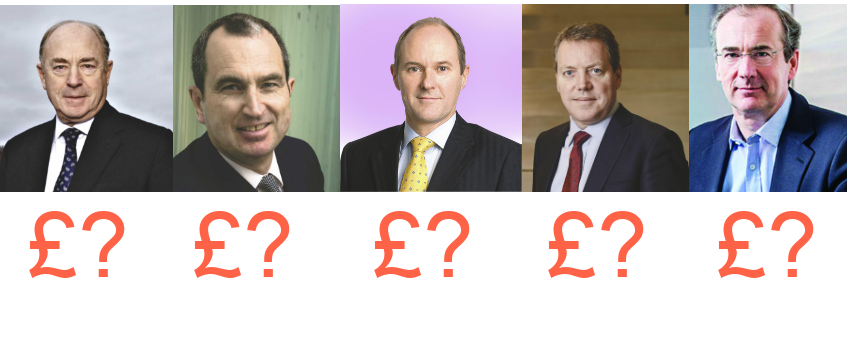What do the top property execs earn?
Earning more than £11m between them, property chief executives’ bonuses rose by 17% in the 2017/18 financial year as the industry recovered from a rocky year following the EU referendum.
However, two saw their pay decrease by double figures… who were they?
Earning more than £11m between them, property chief executives’ bonuses rose by 17% in the 2017/18 financial year as the industry recovered from a rocky year following the EU referendum.
However, two saw their pay decrease by double figures… who were they?
David Sleath, chief executive of SEGRO, was the highest paid for the second year running, netting a total £3.8m – a 1.2% increase on last year. He was one of just four chief executives to meet all their targets for their annual bonus.
Despite being the fifth highest paid chief executive, Helical’s Gerald Kaye was paid the biggest annual bonus at £1.2m. This was a result of the company’s policy capping chief executive bonuses at 300% of their salary – the highest cap in property – and Kaye meeting 75% of his targets.
Helical said it would cut its annual bonus cap to 150% of the chief executive’s salary in its latest remuneration policy.
Total bonuses paid to property bosses this year rose to £12.5m among 24 listed companies – up from £10.6m last year. However, long-term investment plans, which typically reward executives for performance over three years, fell 15% annually.
On average, chief executives earned £1.7m in 2017/18 with an average salary of £500,000. Those in the FTSE 100 were paid on average £2.6m with a salary close to £750,000.
Biggest movers
Landsec’s Robert Noel saw his pay tumble by 37% to £1.7m, falling from second highest paid chief executive to 10th. The decline was a result of missing out on long-term investment awards, which were dependent on outperforming the market in total shareholder return and total property return. Noel was paid £1m in long-term incentive plan (LTIP) awards last year.
Meanwhile, James Gibson, chief executive of Big Yellow Group, saw the biggest increase in total pay – from £867,000 to £2.6m – thanks to his three-year long-term investment plan vesting. Capital & Counties’ Ian Hawksworth had the biggest surge in annual bonuses, achieving 62% of his maximum award – £550,000 – rebounding a year after earning just 21% of his potential bonus.
Hawksworth’s performance was a reflection of a considerably stronger year for Capco’s shareholders. Although NAV was down 1.7%, total shareholder return jumped from -32% in 2016/17 to 8.1% over the past year. The company’s share price also rose 13.5% throughout its financial year, a relatively average performance compared with other FTSE propcos.
Performance v pay
Total shareholder returns rebounded significantly last year from an average of -4.9% to 18.3% and an increase in pay followed.
As the chart below shows, a rise in total pay tended to be in line with an increase in total shareholder returns. Anyone above the trendline received an above average pay rise, relative to the rest of the industry.
Frederik Widlund, chief executive of CLS, saw his pay rise proportionally less than much of the industry. Despite the company’s total shareholder returns rising more than 83.1 percentage points from -16.8% to 67.1%, his pay rose 28.3%. That put him in line with McKay Securities, whose rise in total shareholder returns was around 44.8 percentage points.
Other major outliers include St. Modwen Properties, whose chief executive Mark Allan received £1.2m in share plan awards as part of his recruitment in 2016. St. Modwen had agreed to compensate Allan for unvested share-based incentives awarded by Unite, where he was previously chief executive.
Capital & Regional paid considerably less to Hugh Scott-Barrett and his successor Lawrence Hutchings this year because Hutchings joined midway through 2017, which made him ineligible for LTIPs and a full bonus.
Aligning with shareholder interests
On average, salaries accounted for 32% of total pay among property chief executives, with the majority of the rest coming from variable pay that depends on company performance.
Hemant Kotak, managing director of Green Street Advisors, said this was roughly in line with expectations. Between two-thirds and three-quarters of chief executive pay, he said, should be performance based: “The companies which have a high element of variable pay with those performance targets are generally deemed to be well-aligned with shareholder interest.
“We want good alignment. We want chief executives and board members to be incentivised. The remuneration committee that sets this needs that as a primary objective. UK companies, by and large, actually do a pretty good job on that front.”
Most of the chief executives whose salaries accounted for more than 40% of their total pay – including those at Great Portland Estates, Landsec and intu – were ones whose LTIPs had dipped from last year. That was a reflection of financial performance rather than remuneration policies not aligning with shareholder interests.
Within annual bonuses, financial targets generally make up about 75% of the criteria. The rest are personal or discretionary targets set by the remuneration policy.
Kotak said more emphasis should be given to quantitative targets: “The issue with qualitative is that it can be difficult to monitor from an outsider’s point of view and difficult to know if those targets were sufficiently difficult as a hurdle, and whether those qualitative measures that were in place are closely linked to shareholder performance one way or the other.”
SEGRO and McKay Securities were the only two companies whose bonuses relied entirely on financial targets.
Which companies were included?
The study analysed 24 property companies in the FTSE Main Market with year ends between August 2017 and March 2018, each with a chief executive who receives a pay package that includes bonuses.
To send feedback, e-mail karl.tomusk@egi.co.uk or tweet @ktomusk or @estatesgazette
CREDIT: John Burns / David Atkins (c) Tom Campbell











